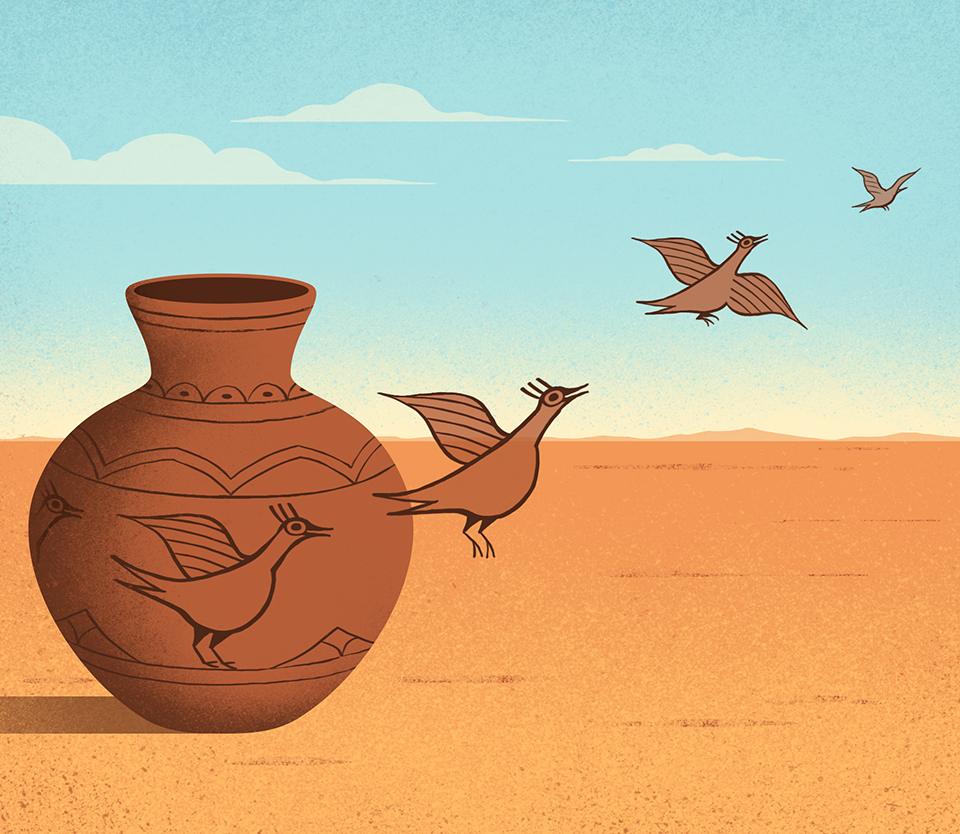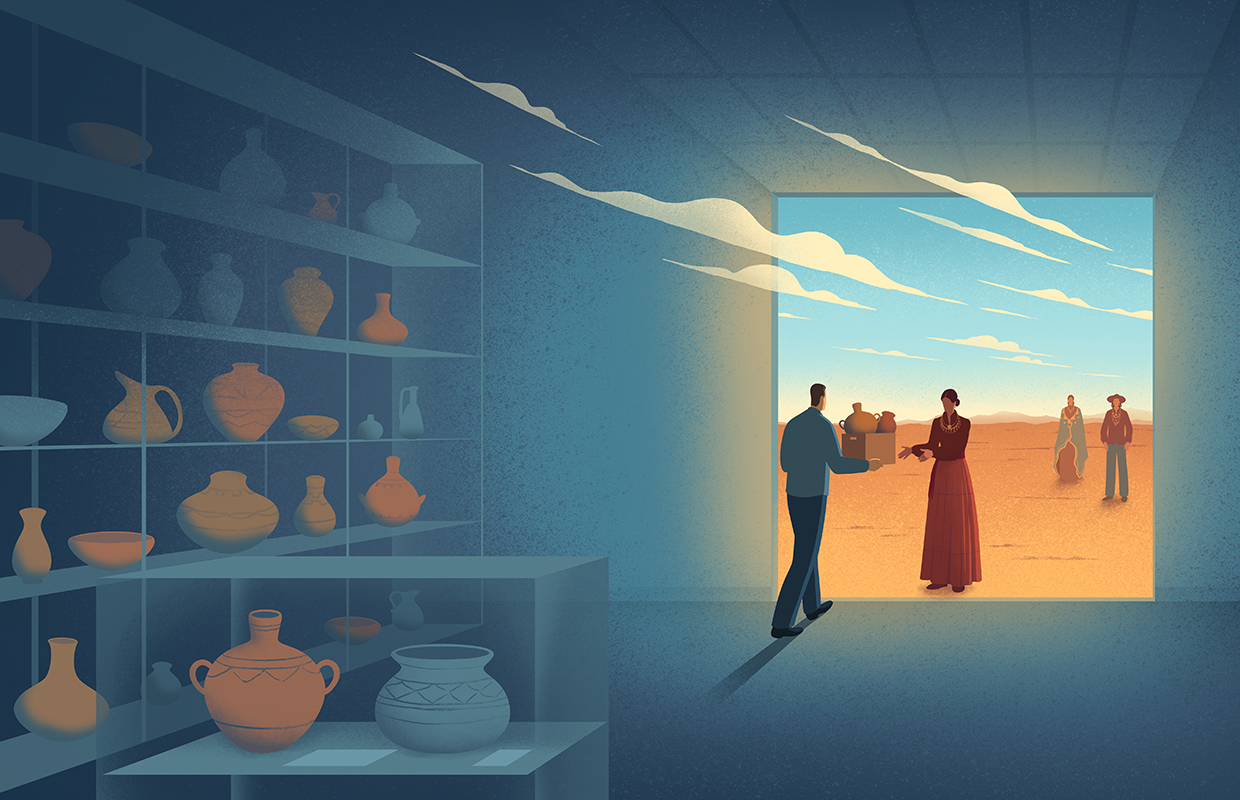The soft earth embraces your grief.
As you stand before your cherished one,
you lay them to rest, holding their memory close
despite the emptiness they leave behind.
As time passes, you find moments
that bring their spirit to life:
the sunlight streaming onto your bed,
a quiet pause on your deck as the world falls silent,
visiting their final resting place with flowers in hand.
But for many Indigenous people, the process of grief has been disrupted. In the 19th and 20th centuries, Indigenous ancestral remains and cultural artifacts were taken without permission from graves and burial sites, either during archaeological excavations or by looters. Many of those remains and artifacts are now being housed at museums and other institutions. According to the U.S. Department of the Interior, the Bureau of Indian Affairs “has located 37 institutions who possess part of the BIA’s NAGPRA collection, encompassing 1,111 individual human remains and over 3,900 associated funerary objects.”
“NAGPRA” is the Native American Graves Protection and Repatriation Act, passed in 1990 after being introduced by then-Arizona Representative Mo Udall. It mandates the protection and return of Indigenous human remains, funerary items, sacred objects and culturally significant artifacts. It further specifies that human remains of any heritage “must at all times be treated with dignity and respect,” and that human remains and cultural items taken from federal or tribal lands primarily belong to “lineal descendants of the Native American.”
The law aims to foster communication between museums and Indigenous communities, enhancing mutual understanding while acknowledging the vital role museums play in preserving historical heritage. And since its passage, NAGPRA has facilitated the return of ancestral remains and cultural items to Indigenous communities, a process known as repatriation. But that process has not been without challenges. Some museums and institutions have been slow to comply, and the work of consulting with tribes and repatriating items has been complex. And some tribes still face difficulties in identifying and recovering their ancestors’ remains, due to a lack of documentation or information about the items’ original locations.
Despite those challenges, the process carries tremendous meaning for Indigenous communities. “I could see clearly, [during] my first repatriation, our ancestors looking straight at me,” says Stewart B. Koyiyumptewa, the Hopi Tribe’s historic preservation officer. He’s a member of the Badger Clan from the Hopi village of Hotevilla, on Third Mesa. And his stance is straightforward: “The ancestors belong in the ground.”
Returning those ancestors to their original burial sites is significant, fundamentally and spiritually, for the Hopi people, Koyiyumptewa says. People whose remains are stored in, for example, a nondescript room at a museum, he says, are “unbalanced, because they’re away from their final resting place, and they’re usually somewhere that’s dark, cold [and] never sees the light of day.”

Underground burial may appear similar in that it’s dark, but it’s fundamentally different, he says. “We also believe that their spirit and their breath live on,” he adds, and if his people “never get to see the elements of the landscape, Earth, the sun [and the] moon,” such experiences in the afterlife may not be possible.
That’s why Koyiyumptewa says it’s essential, regardless of the historical circumstances, to restore his people to their ancestral lands and grant his deceased relatives the eternal peace they deserve. Part of that effort involves collaboration with the Arizona State Museum, at the University of Arizona in Tucson. Byron Cummings, the museum’s first director, initiated the state’s first repatriation in the 1930s, and since 1986, the museum’s Repatriation Office has completed 81 such projects.
James Watson, the museum’s associate director and curator of bioarchaeology, now oversees the Repatriation Office and its three full-time employees. He’s been at the museum since 2008. “I initially got into the discipline because I’m interested in understanding people in the past, and for me, the best way to do that was to study the people themselves and the remains of those individuals,” he says.
Watson’s views on repatriation evolved alongside his work, and he now sees the relationship between descendant communities and their ancestors as a human rights issue. Such communities, he says, should be able to determine the fate of their ancestors’ remains, just like children should decide what happens to their parents’ bodies and belongings when they die. Removal of remains and artifacts, he adds, denied that right to Indigenous people, and repatriation is a way of returning “what has been taken from these communities and trying to heal some of that past cultural trauma associated with the colonial approach to archaeology.”
In recent years, though, a lack of funding impeded the museum’s ability to fully comply with NAGPRA, leading to pauses in repatriation efforts. A recent executive budget proposal by Arizona Governor Katie Hobbs included $7 million for the museum to ensure NAGPRA compliance. The proposed funding would be of great benefit, Watson says, and could help the Repatriation Office hire more staff and convert previous exhibit space to facilitate repatriation work. “We are filled to the brim,” he adds.
With or without the funding, the museum’s work will continue. In the next five years, Watson hopes to “shift from [a focus on] compliance with federal law, and we will have either transferred legal control or transferred all of the individuals and cultural items that are NAGPRA-eligible out of the museum and to tribal communities across the state, and then we can focus on ... managing the constant flow of state repatriation issues.”
Edward Jolie is the museum’s Clara Lee Tanner associate curator of ethnology and an associate professor in the UA’s School of Anthropology. He works as an anthropological archaeologist and serves as a liaison with the Southwest Native Nations Advisory Board, which advises the museum on repatriation. Influenced by his Lakota and Muscogee heritage, Jolie developed an interest in Indigenous history after participating in a public archaeology program in Maryland. “It sort of kindled in me the interest in learning more about what archaeology could tell us about Native American histories and past things that you weren’t hearing as much about,” he says.

Years later, while conducting undergraduate thesis work on a 150-year-old gambling basket belonging to his family, Jolie noticed the lack of research on such artifacts. He recalls reaching out to missionaries and anthropologists about gambling in Indigenous history — and hearing the same response, over and over: “There was never any gambling. They didn’t have that. They don’t. They don’t. Indians don’t gamble.” Jolie would thank them, jot their answers down and move on, only to hear the same sentiment from other anthropologists: “Perhaps you’re not finding anything because there’s nothing to find.” It was an example, he says, of how much of the discourse surrounding Indigenous culture has been shaped by a non-Indigenous viewpoint.
Now, Jolie balances academic research with his ethical responsibilities to Native communities, and he emphasizes the importance of traditional knowledge in modern scientific methods. A lack of that traditional knowledge, he adds, has significantly influenced the public’s understanding of “what it means to be a Native person, or how people identify as Native American.”
When it comes to repatriation, Jolie says, it’s crucial for everyone involved to recognize their own knowledge gaps, given that much of Indigenous history has been documented by non-Natives. That can mean engaging in difficult conversations, he notes, but those conversations are essential to the work.
Watson expresses a similar view. Relationships with tribal communities, he says, “are so critical in order to have open, honest communication about what is an incredibly sensitive and difficult topic to address. And if you don’t develop those relationships, I don’t see why any tribe would have a reason to trust your institution.”
Koyiyumptewa remains dedicated to his efforts on behalf of the Hopi Tribe. Every repatriation, he says, represents a significant commitment, and he thoroughly prepares for each occasion. The very act of laying to
rest ancestors who should have remained undisturbed in the ground contradicts his cultural beliefs. “It never erases from your mind,” he says — but in returning them to the desert where they once grew their crops, he sees a revitalization of his community’s connection to its ancestral lands.
“Maybe I’ll know when I pass on to the afterlife that it is rewarding — that the ancestors that I did bring home may be waiting for me,” he says. With each repatriation, he offers prayers for positive outcomes. His concluding prayer, to his ancestors, seeks their forgiveness for how they’ve been treated and expresses hope that they’re grateful for their return. And to each ancestor, he prays, “Come to us with clouds, so that we can continue to maintain our way of life as Hopi people.”

